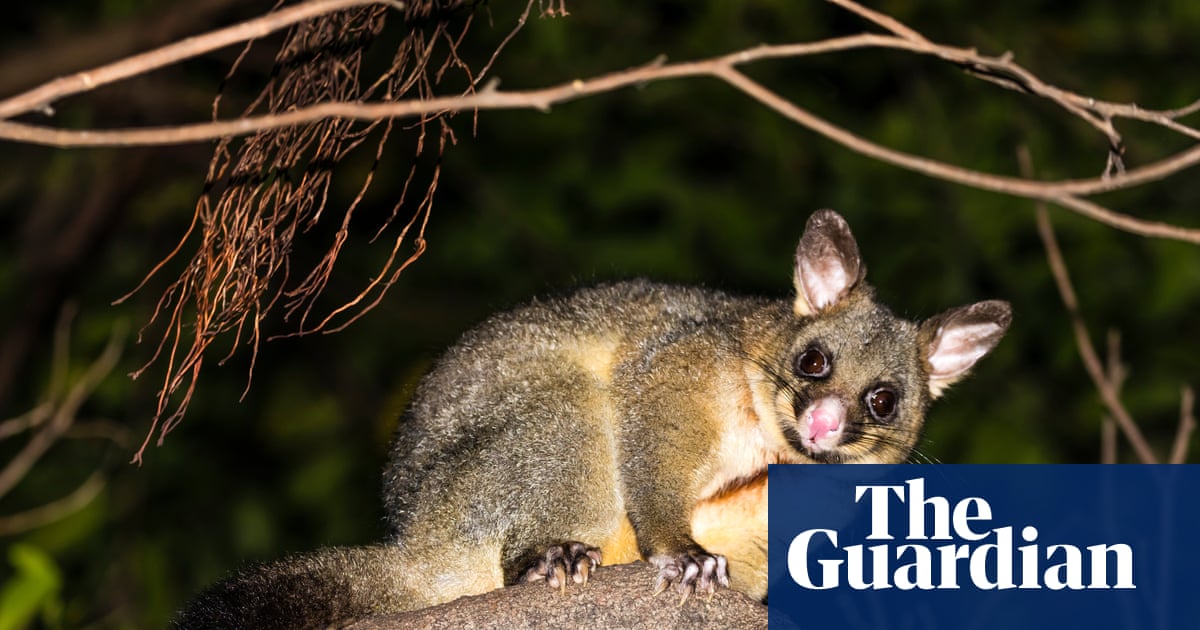Chopping vegetables in my kitchen on a winter afternoon, I was startled by the sound of rustling branches and loud coughing coming from my back yard.
I walked outside tentatively, prepared to face a fence-hopping intruder. Instead, after a few minutes of listening to evenly timed wheezes, I spotted it – a small brushtail possum, tucked behind lilly-pilly branches bowing over my fence.
Through the leaves, two black eyes peered desperately into the afternoon sun, eyelids dotted with pus. Its pink nose was swollen and its body and limbs were a patchwork of rashes, with pieces of fur missing across its torso.
Huffing and bloodied, the possum looked like a once-loved teddy bear – greying, losing its stuffing and left to decay in the garden.
My bleeding heart took over my head and I dashed inside and grabbed a bag of frozen berries, dumping a handful in a glass of water to thaw before wandering out and dropping a few wet fruits on the fence.
Over the afternoon I watched the sick possum pick up berries, nibbling while purple juice dripped off its chin. As the sun set it put its head into its chest, wheezing itself to sleep.
Feeding native wildlife is a divisive topic. While some throw mince to kookaburras with wild abandon, others tut tut, insisting it’s best to let them fend for themselves.
I called the wildlife rescue organisation Wires, which advised us to capture the possum so it could receive veterinary care. As my husband slowly approached with an old bath towel, in a scene not dissimilar from the 1931 film Dracula, the possum suddenly reanimated, screeched loudly then scampered into the night.
Despite its terror it was clearly tempted by the prospect of more thawed-out berries because a few days later it returned. But I was not keen on trying to catch the possum again. After seeing it thrash around in fear, I worried that the stress of the ordeal might actually hasten its death. Diligently, and against best advice, I began leaving food for it.
Providing slices of apple and carrot seemed like a neighbourly thing to do. But regular offerings might harm an animal more than they help.
Brushtail possums in a natural environment eat native shrubs, plants and leaves. This is why a professor of behavioural ecology, Clare McArthur, says feeding brushtail possums should largely be avoided: “What are we doing to their gut flora? How good is [the food] we’re feeding them?
“If they become reliant on us, what happens when we go away?”
John Grant from Wires says feeding poses other risks, too. “They can also become ‘humanised’ and lose their natural fear of potential predators including domestic pets,” he says.
“Possums (and native birds) are best fed with native foliage, so planting native trees and shrubs endemic to your area helps provide them with a natural food source.”
Male possums being routinely fed can also become stressed when other males, keen for an opportunistic meal, encroach on their territory, which they naturally want to defend, according to a Taronga veterinary nurse, Annii Downing.
after newsletter promotion
McArthur says giving a brushtail the odd piece of healthy food might not be a cardinal sin. “Now and then, it would be OK, because one of the virtues is that we start to value the wildlife around us. So it’s not a yes or no thing. It’s a fine line.”
While official advice on wild animal feeding skews negative, Prof emeritus Darryl Jones from Griffith University agrees that responsibly interacting with urban wildlife can increase people’s compassion for animals.
“No wild animals in Australia need extra food,” Jones says. “The reality is, millions of people every single day are feeding birds, and can’t find any information.”
Compelled to counter this information void with facts, the behavioural ecologist, bird feeder and author of 10 books wrote a popular Australian field guide to urban birds, Feeding the Birds at Your Table.
“If you Google ‘What should I feed my magpies’ you’ll get inundated with huge amounts of negativity,” he says. “That’s my thing … to reconnect people with nature.
“Only when people care about, look for, observe and just try and understand the wildlife around us will they care enough to protect them.
“That’s the big philosophical side to this.”
Just under a year on, I still see the possum on our fence. Its wounds have healed, it no longer wheezes or wobbles.
Instead it has taken to chewing my veggie patch, gnawing rainbow chard and parsley down to the mulch line every few days. While I used to enjoy my own harvest, I now laugh at what the picky possum has chosen and wonder why it doesn’t like lemon thyme.
Some nights, it seems as though there’s been a possum party. I wake to lilly-pilly fruits strewn like confetti across our concrete back yard.
And every so often my husband still leaves out an apple slice for the possum. Even though we know we shouldn’t. Philosophically, though, I think it is sound.
